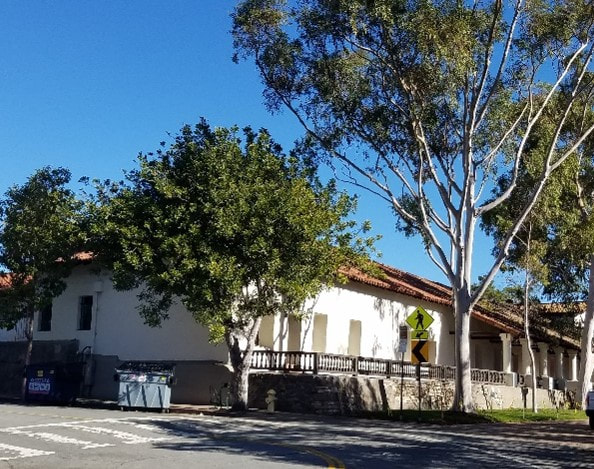*** This tour was published in March 2021, when the Covid-19 pandemic was active. Please wear a mask/face covering and maintain a social distance of 6 ft from people not in your household. Visit www.emergencyslo.org for the latest in public health advice. ***
A Self-guided Walking Tour of Mission Plaza in 1858 and the Committee of Vigilance
Site 3: Old Mission Convento Wing - Site of 1858 Jail & Courthouse
In 1858, Mission San Luis Obispo was still privately owned. Three years later, title would be restored to the Diocese of Monterey, but at the time of the Vigilantes, the convento wing of the Mission was still being used by the Sheriff as a jail and courthouse. It is here that the seven Californios were incarcerated before their execution.
In 1858, Mission San Luis Obispo was still privately owned. Three years later, title would be restored to the Diocese of Monterey, but at the time of the Vigilantes, the convento wing of the Mission was still being used by the Sheriff as a jail and courthouse. It is here that the seven Californios were incarcerated before their execution.
|
In 1857, this wing had also served as the jail and courtroom for the trial of Nieves Robles, charged with the murder of two Basque cattle drovers on Peachtree Road northwest of Paso Robles. In late December, Robles was arrested and charged with the crime, but on that occasion, he was given a trial AND an attorney. It would be another century before accused criminals would be entitled to a Public Defender – so who would defend this miscreant, known to have committed similar crimes in Northern California but never convicted? None other than Walter Murray, the young lawyer who had just passed the bar and was seeking to build his reputation among the other white “Americans” who were flocking to town. And who paid Murray’s bill? Not Robles himself, but his friend and drinking companion Jack Powers.
|
With Murray’s representation, and with no evidence nor any reliable witnesses to place him at the scene of the crime, Robles was acquitted and allowed to walk free on March 5, 1858.
|
The trial of Nieves Robles, Murray later claimed, was tainted by the presence of Californios with Spanish/Mexican ancestry on the jury. In a letter to his sister, he wrote that “public opinion among this bastard people cannot be trusted… Law could not help us. Law was powerless anyhow before a jury of these people.”
Robles could not have known that when he was acquitted and walked out of the courtoom on March 5, he had only a few months to live: On June 28, he would be the last of the seven Californios to die on the gallows – this time facing organized Vigilantes, however, without the benefit of a trial or a skilled attorney like Walter Murray. In fact, Murray had “switched sides” and by that time, he was a leader of the Vigilantes. |
At Site 2, we learned about the hanging of Santos Peralta in his cell in this jail and, a week later, the hanging of Jesus Valenzuela.
The next two victims of the Vigilantes were, respectively, Luciano Tapia and Juan Antonio Garcia. To understand how the Committee of Vigilance was created, and why it ultimately was disbanded, cross the walkway to Site 4, the remains of the Murray Adobe.
The next two victims of the Vigilantes were, respectively, Luciano Tapia and Juan Antonio Garcia. To understand how the Committee of Vigilance was created, and why it ultimately was disbanded, cross the walkway to Site 4, the remains of the Murray Adobe.


